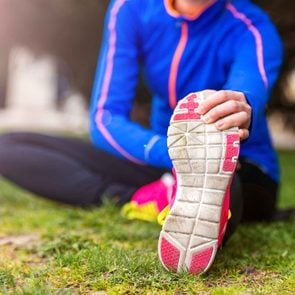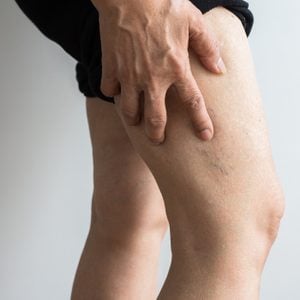I Wore Compression Socks for a Month, and Now I Can’t Live Without Them
Updated: May 20, 2021
I always wondered, what are compression socks used for? I thought they were for the elderly, but they worked for me—and changed my life.
Thanks to my stubborn genes, I have edema, or chronic swelling in my ankles. As if cankles weren’t bad enough, varicose veins made an appearance in my forties (thanks to genetics and three pregnancies), with a side of restless leg syndrome (RLS) thrown in just to seriously mess with my sleep. Wait, there’s more… before I turned 50, I had to pee at least twice, sometimes three times, a night. This is annoying enough at home, but when you love camping, it’s downright exhausting to get out of a sleeping bag, unzip the tent, and walk into the dark unknown to find the toilets. I’m not big on popping pills, so I decided to do my own research on possible natural remedies for RLS. I read about nocturia (the fancy term for having to pee frequently at night) and found out what compression socks are used for, according to the Urology Care Foundation: They’re good at relieving most of my issues, but especially nocturia. Ugly or not, I had to give them a shot.
Wearing compression stockings was oddly comfy
I ordered graduated compression stockings, which means the compression is strongest at the ankle and gets lighter up the leg. I’m not going to lie: When I pulled them up to my legs, I instantly felt like I was 90 years old (no offense to my dear grandmother). They were also really snug, and I was worried that they would cut off my circulation and leave me passed out on the floor.
But during the next few hours, I noticed that my legs felt oddly comfy in the compression socks. They felt stronger and didn’t ache as much. Great for daytime, but what would happen that night when the usual heaviness and “urge to move” set in my legs? I took the socks off after dinner. Sleeping in compression socks is an option for some, although I chose not to sport them once I went to bed. It all depends on why you’re wearing them, so talk to your doctor to find out if sleeping in them is right for you. I settled in to watch TV and was shocked that I didn’t have to get up and move around or do heel raises to alleviate the restlessness in my legs!
(Check out the best compression socks that experts recommend.)
I didn’t have to pee as much at night
Next up: the nocturia test. I did get up to pee that night, but only once, and at my age, that’s normal. I woke up the next day refreshed for the first time in a long time. Could this just be a placebo effect?
I wore the socks during the day for the next 29 days with the same results—when I didn’t forget to wear them. Early into the 30 days, I forgot to wash my socks and boarded a cross-country flight without wearing them. The urge-to-move feeling in my legs was unbearable, and I didn’t want to keep troubling the people in my row to get up and walk the aisles. I should have worn the dirty socks! Not long after that I took a long road trip to a camping and hiking destination and thankfully wore my socks. Big difference: No restlessness and only one potty break.
My circulation headed in the right direction
So what are most people using circulation socks for? Improving circulation, primarily. The socks gave my poor circulation a boost in the right direction—as in, away from my ankles and back up to my heart, increasing blood flow to all my vital organs. The stockings can also help prevent blood clots.
Now that I’m going to be wearing compression socks on the regular, I’ve graduated from the fugly, beige variety and found a plethora of more colorful, more flattering styles. If you’re considering checking them out, stick with a 15 to 20 mmHg for mild symptoms, or consult your doc before trying socks with greater compression.



